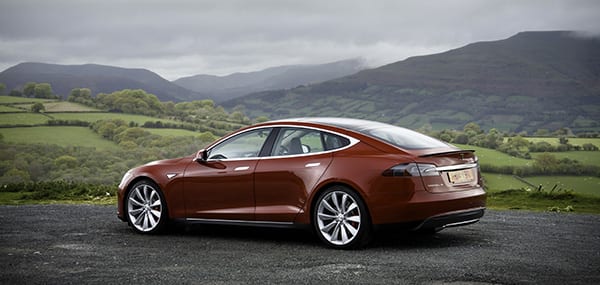The Tesla Model S electric car has achieved a 5-star safety rating from both the European New Car Assessment Program (NCAP) and the NHTSA. This says a lot about the unusual technology behind this car.

Every vehicle has its strengths and weaknesses, and unfortunately: manufacturers skimp on one thing or another to meet their design goals without exceeding their target price. Tesla did what all manufacturers should be doing, and that is taking advantage of the benefits that electric vehicles can offer and building them from the ground up, rather than trying to convert existing gasoline-powered vehicles to electric.
The result of that is a large crumple zone at the front of the Tesla Model S (where a motor and/or batteries would likely be in an EV of another brand). Tesla Motors places the batteries and motor along the floor of the vehicle.
According to a Tesla Motors press release:
Model S is one of just a few cars to have ever achieved a 5-star safety rating from both Euro NCAP and the U.S. National Highway Traffic Safety Administration (NHTSA). Additionally, Model S is the only car this year to have achieved both a 5-star Euro NCAP rating and 5 stars in every NHTSA subcategory, including frontal impact, side impact, and rollover. Only two other cars have earned the same recognition since 2011 (when NHTSA introduced its latest rating scheme).
The reason so few models achieve 5-star ratings in both Europe and the U.S. is that each program places emphasis on different safety aspects in the assessment process. NHTSA emphasizes structural and restraint safety, with a deep focus on how well the vehicle can withstand and absorb the energy of an impact while protecting its occupants. It is also primarily concerned with adult occupants. On the other hand, Euro NCAP assesses a wider range of scenarios, including tests for child and pedestrian safety. Unlike for NHTSA, active safety is also an important part of Euro NCAP’s 5-star requirement. Every year, the European organization raises the standard for a 5-star rating to account for technological advances in the industry.
Theoretically speaking, electric vehicle manufacturers could enhance vehicles further with a design that has even more undercarriage space by using in-wheel motors + electric braking. This could theoretically enable them to reduce the size of the friction brakes. This would enable them to shift even more parts from the front, rear, and side to the undercarriage and increase the crumple zone of all those areas.
I hope that Euro NCAP and NHTSA standards are revised to a scale of 10 stars, because so many vehicles get 4 and 5 start ratings that it is hard to tell how safe they really are compared to the competition. They should also start factoring in the likelihood of an accident via the measurement of braking distance, pitch, and turning circle.
Source: Tesla Motors.









